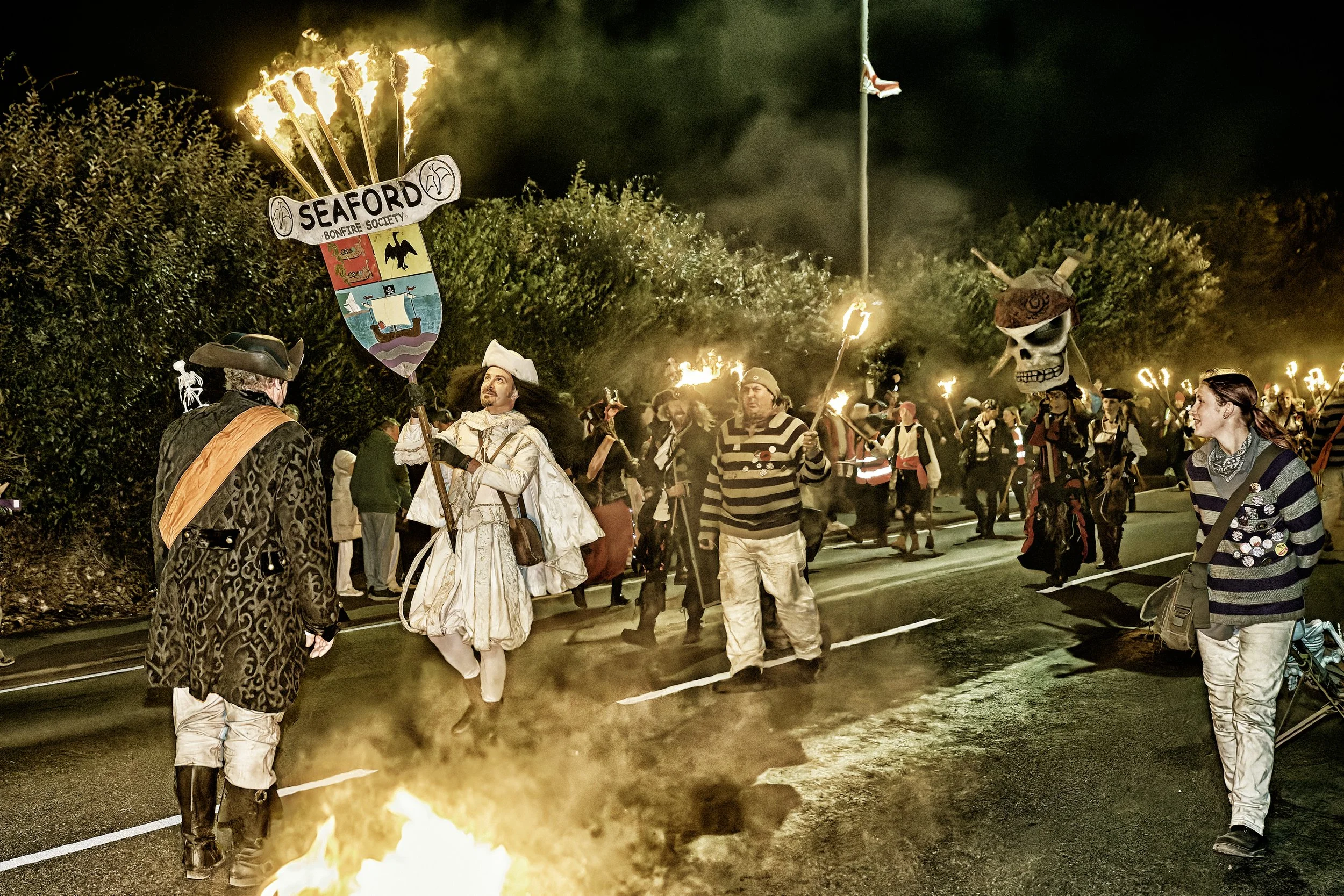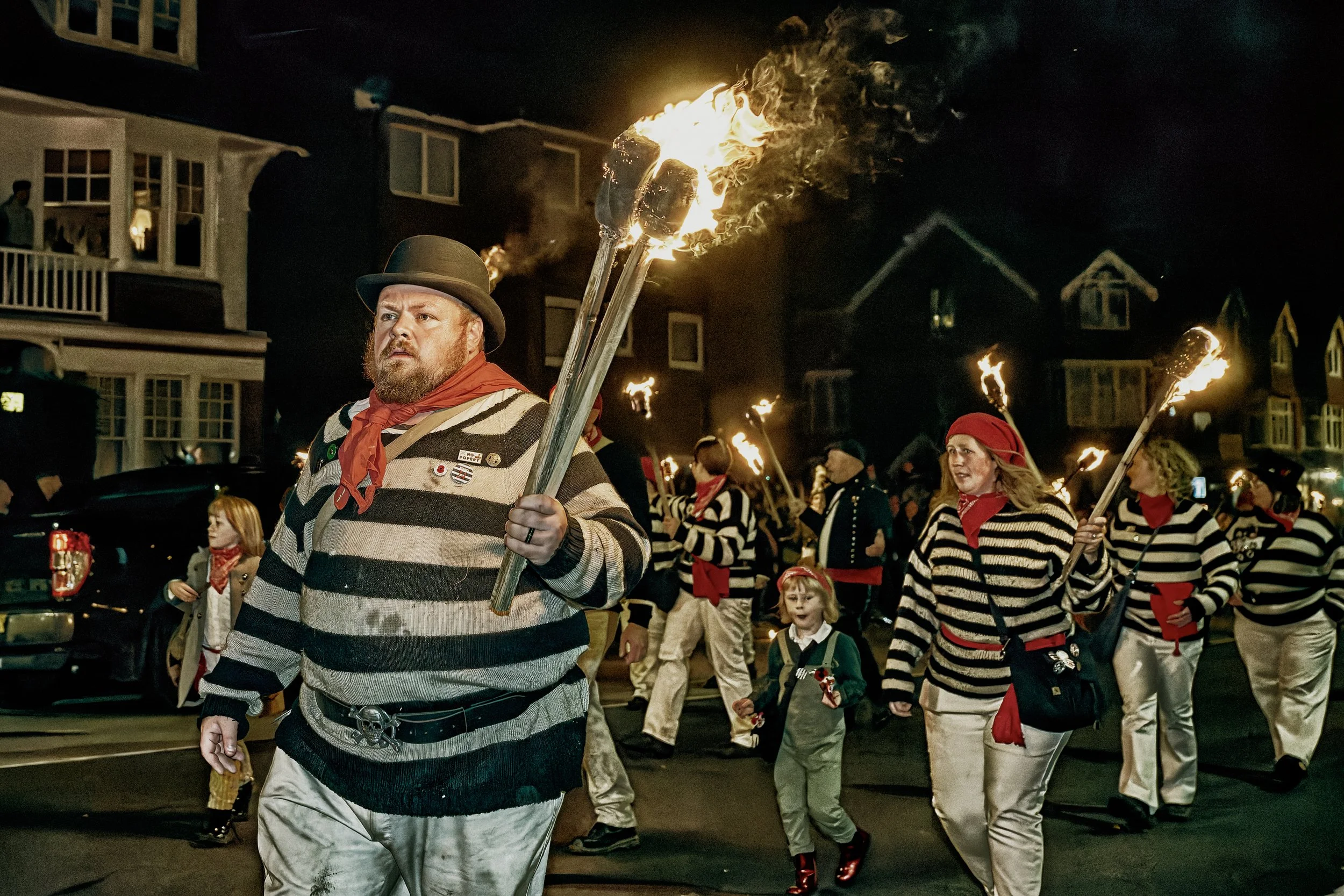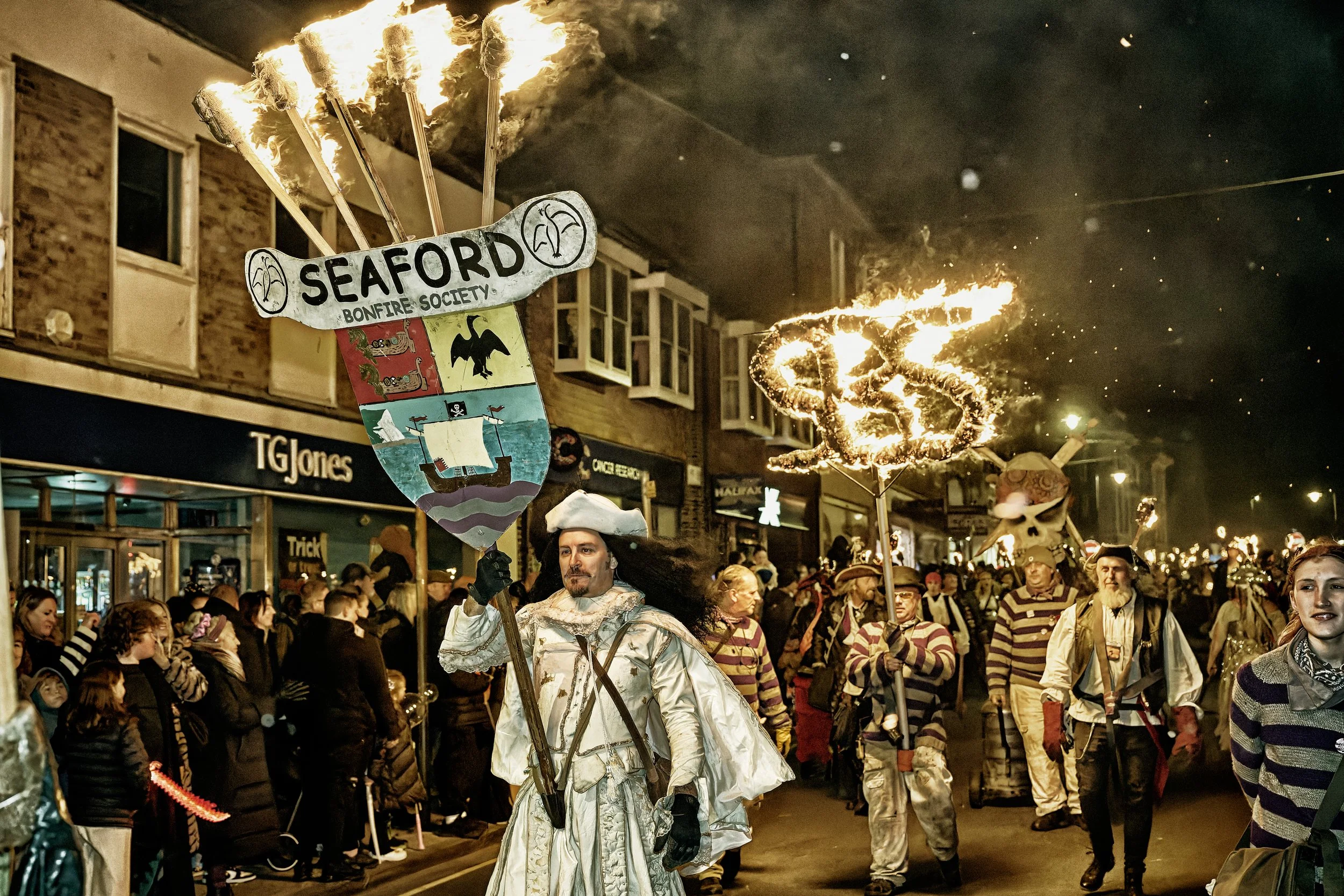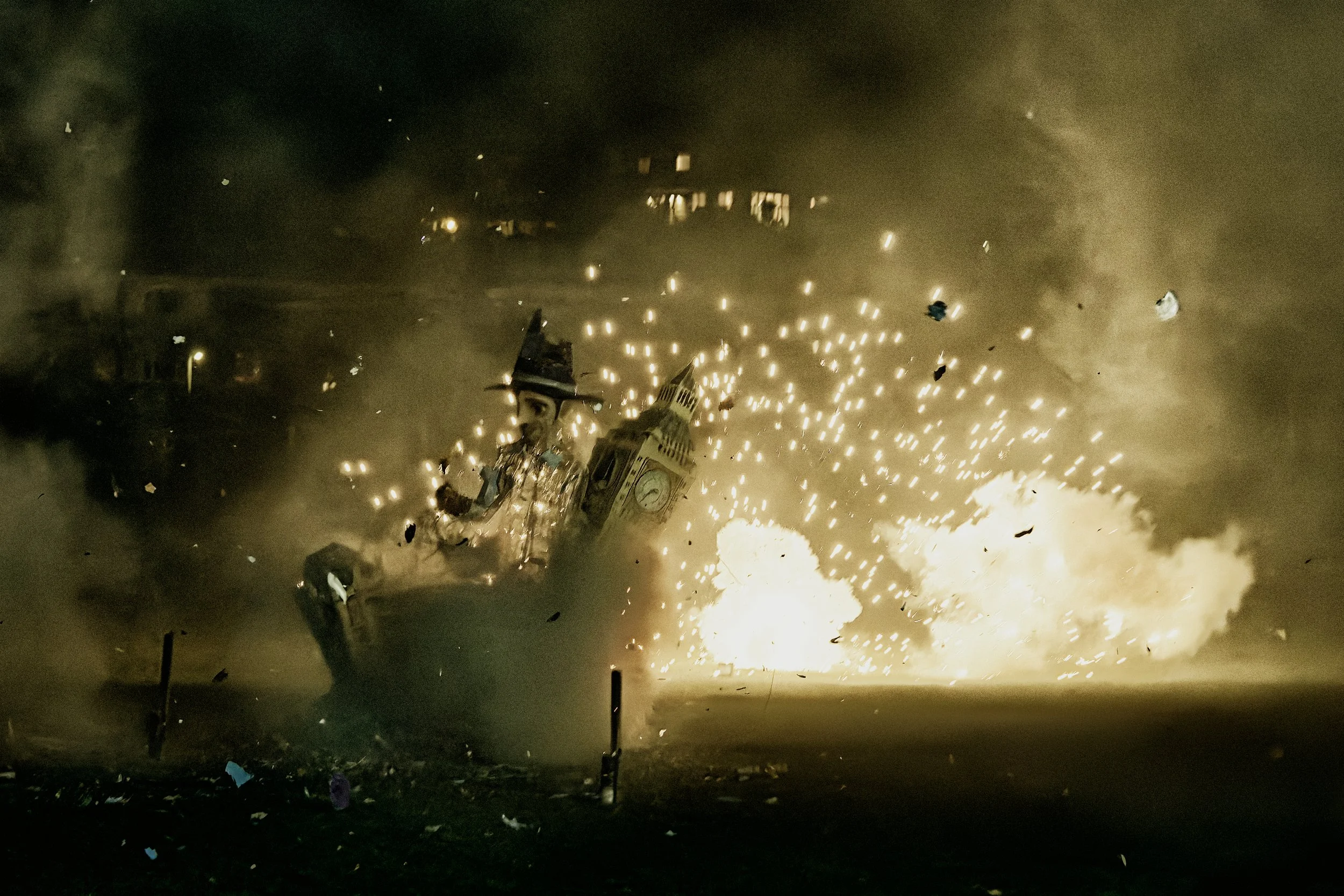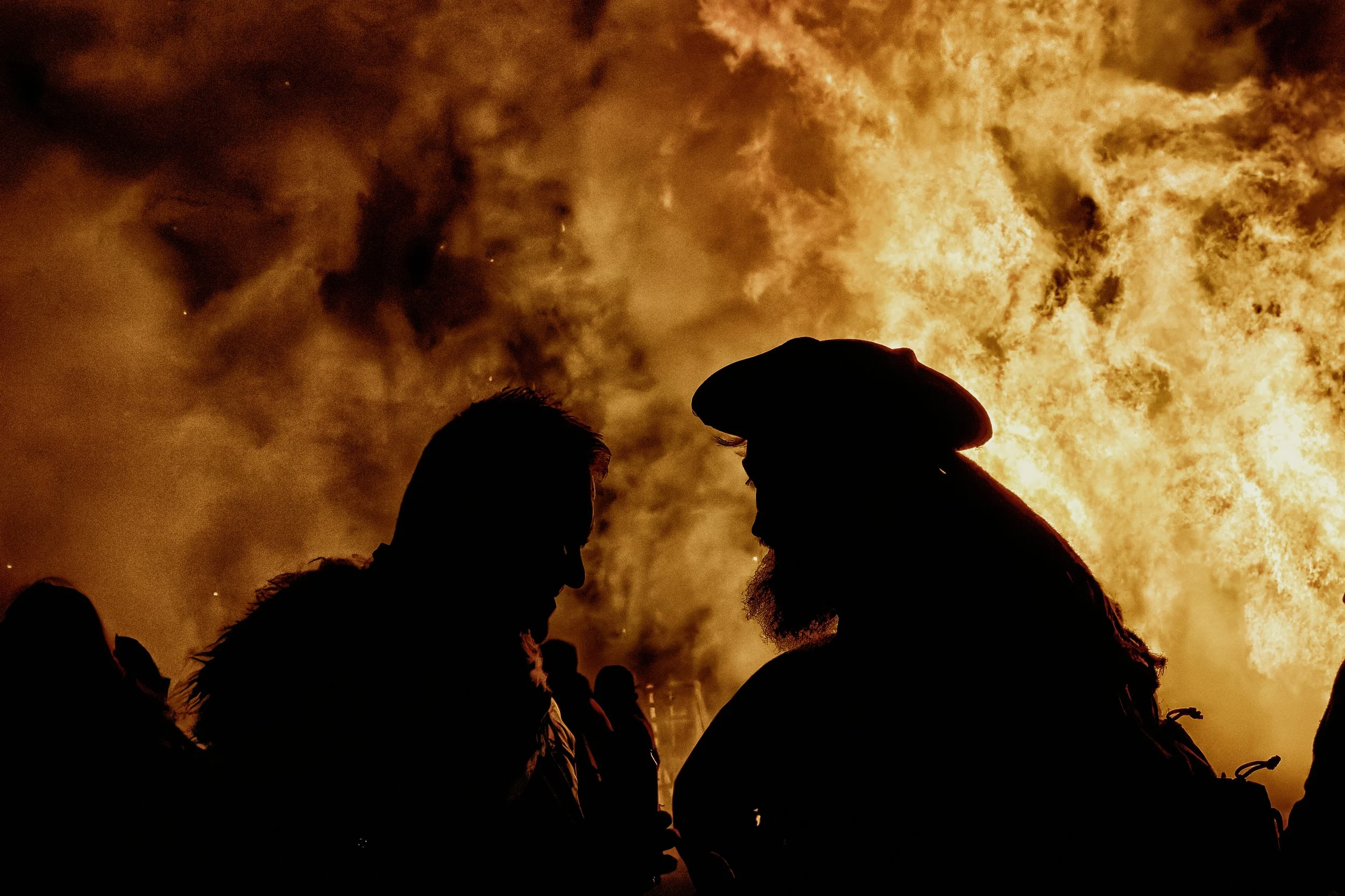Treason and Treachery
A Dagger in the Heart of Family and Faith
A Catholic lord, caught in the recusant network through marriage to a Gunpowder Plotter’s sister and kinship with related families, prioritised the Crown’s favour over the sacred bonds of faith and family.
While Bonfire Night is a beloved nationwide celebration in Britain, honouring the thwarted Gunpowder Plot of 1605 with spectacular fireworks and family festivities, Sussex takes the excitement to a whole new level. Its local version is a thrilling, multi-week extravaganza that bursts with energy, featuring reenactments that transform the gunpowder custom into an unforgettable history festival.
Sussex is truly a firework of tradition, home to over 35 lively Bonfire Societies—the most of any region in Britain. But among this spectacular array, why pick Seaford? Because Seaford weaves a tale of intrigue, folklore remembers that King James I rewarded the man who uncovered the Gunpowder Plot with lands in East Seaford to recognise his heroic act that saved the King’s life.
Seaford Bonfire Procession ©Martin Urch
History
Seaford thereby holds a distinctive place in Gunpowder Plot history, rich with a connection waiting to be uncovered. Before diving into the Bonfire event, let’s delve into its past through the eyes of Lord Monteagle, the expositor of the plot. In the shadowed undercurrents of 1605 England, where Catholic recusants whispered of rebellion against King James I’s Protestant yoke, William Parker (1575–1622), the 4th Baron Monteagle—a devout Catholic—stood at the precipice of loyalty and betrayal.
Lord Monteagle was a prominent figure in the English aristocracy and a member of the House of Lords. His wealth and status were built upon inherited estates, sprawling lands, and rental incomes, painting a picture of nobility. Among his holdings were grand estates in Essex and London, with family ties that traced back to royal favour in earlier generations.
He hailed from a distinguished Catholic non-conformist family, known for their quiet resistance and sympathy towards Catholic causes even during Queen Elizabeth I’s reign. However, by 1605, he had dramatically shifted stance: publicly denounced radical Catholic plots and pledged unwavering loyalty to King James I. He outwardly embraced the Church of England to restore his standing at court, marking a turning point in his life and allegiances.
However, Lord Monteagle was deeply intertwined with the Catholic plotters behind the Gunpowder Plot. His family ties ran strong—his brother-in-law, Francis Tresham, was a key conspirator and the son of Sir Thomas Tresham, himself a devout Catholic. Moreover, Lord Monteagle’s familiarity with Robert Catesby, the conspiracy’s mastermind, and Thomas Winter reveals a complex web of personal connections and clandestine secrets.
On the evening of October 26, 1605, while Lord Monteagle was dining at his London home in Hoxton, his life turned. His servant delivered an anonymous handwritten letter—now preserved in the UK National Archives—firmly urging him, as a member of the House of Lords, to skip the looming Parliament opening on November 5th to avoid a vague but dire fate. The letter includes:
““…for God and man hath concurred to punishe the wickedness of this tyme, and thinke not slightly of this advertisement, but retire yourself into your country, where you may expect the event in safety, for though there be no apparance of anni stir, yet I saye they shall receive a terrible blow this parliament and yet they shall not seie who hurts them this cowncel…””
One theory suggests that Francis Tresham authored the mysterious letter, only to deny it later. Alternatively, some believe that upon uncovering the plot verbally, Lord Monteagle penned the note in a daring attempt to gain favour with the King. Regardless of its origin, torn between blood ties and self-preservation, he did not burn the letter or seek quiet counsel among his Catholic brethren. Instead, he galloped to Whitehall in calculated ambition. He thrust it into the hands of Robert Cecil, the Earl of Salisbury—King James’s spymaster and architect of Catholic persecution.
A third conspiracy theory centres around the cunning Robert Cecil, whose watchful eyes seemed to see everything. According to the theory, Cecil knew the plot’s conspirators and their connection to Lord Monteagle. The letter in question was supposedly written at Cecil’s command, serving as a test for Monteagle and a safeguard for his secret sources. Make of that what you will. Regardless of the letter’s true origins, what happened next is known.
On November 4th, guardsmen made a shocking discovery deep within Parliament’s underground chambers—Guy Fawkes was caught red-handed, guarding an astonishing 36 barrels of gunpowder hidden beneath firewood and coal, with ignition tools at his side. After intense torture, a damning confession set off a dramatic manhunt, and the plotters were swiftly captured. In a fierce gunfight, some met their end. After his arrest, Francis Tresham confessed his involvement under interrogation and died in the grim isolation of the Tower of London. His corpse was unceremoniously dumped in a pit on Tower Hill, his severed head spiked over Northampton’s gates. Others arrested faced gruesome public execution after their brutal torture. They were hanged, drawn, quartered, and beheaded—stark warnings of treason’s deadly consequences.
Lord Monteagle’s vigilance earned him a princely reward from the King: a hefty £500 in cash and £200 worth of lands, believed by the Seaford community to be located to the east of the town. To his co-religionists, Monteagle was Judas reborn: a betrayer who traded for a baron’s gilded survival, ensuring the plot’s fiery dream crumbled to ash and infamy. Once whispered in prayer, his name echoed eternally in the Catholic lament—“Remember, remember, the fifth of November”—not as saviour, but as the serpent in their midst.
This daring episode secured Lord Monteagle’s place in Britain’s history and cemented his legendary status as the hero who thwarted one of Britain’s most notorious plots. Today, Lord Monteagle is celebrated yearly as a costumed figure leading the vibrant Seaford Bonfire procession.
Seaford Bonfire
Monteagle outside the White Lion with Guy Fawkes effigy ©Martin Urch
Everything bursts into life at the bustling White Lion Inn, the vibrant heart of the Seaford Bonfire Society, kicking off my visit. Arriving at 5 pm, two hours before the grand procession, I was swept up in the atmosphere as a parade of colourful, flamboyantly dressed figures had already gathered, eager to revel in the festivities and sip on refreshing drinks. Lord Monteagle sat prominently among them, perfectly positioned in front of the dramatic Guy Fawkes tableau made of bamboo, willow, and paper—a sight to behold.
Monteagle just after his torches are lit. ©Martin Urch
While I savoured a juicy cheeseburger and a refreshing ale, the costumed figures gathered along Belgrave Road, collecting their paraffin-soaked torches in anticipation of the parade. Every year, artisans craft over 2,000 handmade torches from wooden batons, felt, and wire—each one meticulously packaged to withstand the coastal winds of Seaford. As the clock strikes 7 pm, fireworks light up the sky, signalling the parade’s start. The procession begins at Claremont Road, with its long, shimmering tail sweeping gracefully into Belgrave Road, igniting the night with celebration.
Monteagle leading the bonfire procession ©Martin Urch
Two blazing wheeled barrels led Lord Monteagle proudly through the streets, heralding the Seaford Bonfire Society’s grand parade. Following closely behind, around 700 vibrant parade participants showcased their creativity in themed costumes—from daring Pirates to enigmatic Seaford Shag Smugglers, rhythmic Pentacle and Phoenix Drummers, proud Saxons, and visiting bonfire societies dressed in striking costumes. The energetic beat of the drums echoed loudly, punctuated by ear-splitting explosions from barrels. This is going to be good.
Pirates ©Martin Urch
The costumes are truly spectacular, showcasing incredible creativity and effort that fills the air with infectious joy within the community. Streets overflow with thousands of spectators, eagerly watching as the parade marches at a lively pace. It passes by the railway station and winds along Clinton Place to the Memorial, where a heartfelt tribute is paid to those who sacrificed their lives in war. After a solemn moment of reflection, inspiring songs are sung, and the poignant Bonfire Prayer is read, creating a moving and memorable experience.
The traditional Sussex Bonfire Societies’ Prayer to commemorate the Gunpowder Plot of 1605 begins:
““Remember, remember the Faith of November
The Gunpowder Treason and plot
I see no reason why Gunpowder Treason
Should never be forgot….””
War Memorial fireworks ©Martin Urch
This first segment of the parade culminated in a spectacular burst of ground firecrackers launched from a pyramid frame. I was so close that I felt the shrapnel bounce off my skin as the sparks scattered around me—a truly exhilarating finale to the first act. Participants then eagerly seized new torches, while the knowing crowd swiftly stepped back, giving room to pass. With excitement in the air, we marched down Broad Street, our sights set on the inviting shoreline ahead.
Seaford Shags in their distinctive hooped jumpers ©Martin Urch
Nestled along secluded beaches and rugged terrain, Seaford whispers tales of a storied smuggling history. One group of Bonfire Society members, the Shag Smugglers, wore distinctive hooped jumpers and neckerchiefs, with symbols inspired by the town’s proud cormorant emblem and maritime wrecker folklore. Among other eclectic members celebrated on Seaford’s Crest are the Pirates and Saxons. Seaford Bonfire Society is a vibrant group that revived itself in 2010 to breathe new life into Sussex’s traditional torchlit processions—an enchanting homage to Seaford’s rich past.
Seaford Bonfire Society’s torch banner blazed ©Martin Urch
The parade surged through the High Street’s shops, where the Seaford Bonfire Society’s (SBS) torch banner blazed spectacularly. The flickering flames reflected brilliantly in the narrow gaps between shop windows. My frantic weaving and dodging around the fiery torch barrels with a camera felt like an exhilarating dance. Finally, we arrived at the Martello Fields, which lie against Seaford Beach. Several stories high, a colossal bonfire came into view—an incredible creation that a dedicated team had spent three intense days building. Excitement for pyrotechnics was everywhere!
Parliament and Guy Fawkes explodes ©Martin Urch
Imagine the thrill as a staggering 10,000 spectators flocked onto the bonfire field. As each Bonfire Society strode onto the arena, lively announcements crackled over the PA system, revealing their unique styles. The traditional Bonfire Prayer echoed through the night once more, building anticipation. Then, the sky lit up with breathtaking aerial fireworks, though I’ll spare you the photos since you’ve seen fireworks before. Instead, I focused my camera on the ground firework display that followed, equally mesmerising, culminating in a jaw-dropping explosion of the Houses of Parliament tableau.
Blazing bonfire ©Martin Urch
A huge splash of paraffin was poured around the base for igniting a towering bonfire of pallets. As the flames erupted, the sea breeze whipped them into a wild, dancing inferno. Within moments, the entire stack was engulfed in fiery glory, its intense heat pushing towards the cheering crowd, carried on the onshore wind. The blaze reached a breathtaking peak, prompting us all to step back. No wonder the bonfire is saved for last — it’s the ultimate spectacular finale!
Epilogue
Saxon-themed costumes at Seaford Bonfire ©Martin Urch
King James I’s choice of public bonfires to mark his escape from murder is a fascinating detail. The tradition of late October and early November celebrations with fire has deep roots, dating back to before the Medieval Saxons’ Winterfylleth (winter full moon) celebration.
During the earlier Iron Age Celtic pagan period, Samhain was a sacred bonfire festival that marked the end of the harvest and the start of winter. According to the solar calendar, this will take place on October 31st. It was believed that during Samhain, the veil between the living and the dead was at its thinnest, making it easier for spirits, ancestors, and supernatural beings to cross into the world of the living. People would light bonfires to honour and communicate with these spirits, forging a powerful connection between the realms.
Spooky themes at Seaford Bonfire ©Martin Urch
The Christian festival of All Saints’ Day, celebrated on November 1st, adopted the timing of the pagan Samhain. All Hallows’ Day festival builds on the original Celtic traditions. Just the night before, October 31st, is celebrated as Halloween or All Hallows’ Eve, a time rich with spooky festivities.
And here’s a fascinating reveal for 2025: November 5th coincides with Samhain based on the lunar calendar—the Winter (full) Moon. It’s a remarkable alignment that adds a mystical layer to Guy Fawkes festivities across Britain this year!
These intriguing connections set the stage for my upcoming December publication, where I’ll explore the mystical significance of Glastonbury Samhain. Stay tuned for an enlightening journey into ancient traditions and their modern echoes!
What Next?
Experience the mystical Glastonbury Wild Hunt & Samhain Festival in my December photo essay! Vibrant rituals, ancient traditions, and enchanting moments await. Dive into the magic! #Glastonbury #Samhain
Martin Urch Photography owns the copyright to all writing and images.



